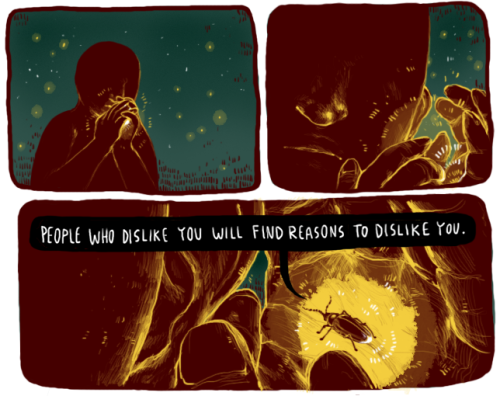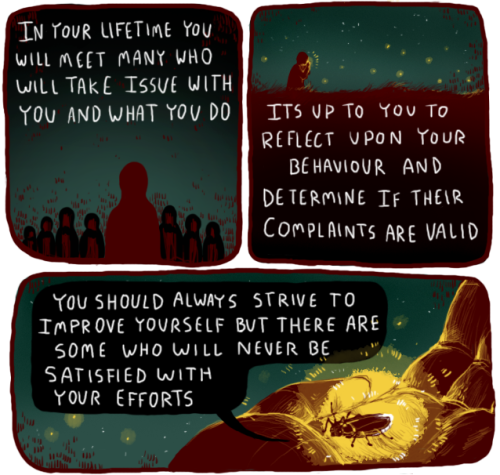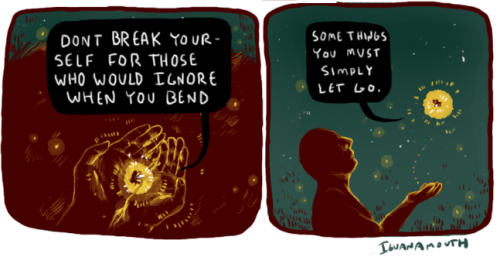"I Never Knew I Could Feel So Much Pain, And Yet Be So In Love With The Person Causing It..."





"I never knew I could feel so much pain, and yet be so in love with the person causing it..."
More Posts from Pandora-allan and Others
@more-like-reyna thanks for the tag!
1. When I was a kid, my parents had to leave me in their friends' houses for days, because at that time, they had to work in different areas and I basically lived more than 20 houses until I turned in to 12. I actually kinda like it, cos it really helped me to have lot of experiences with people I 'd never known.
2. I'm currently studying at a girls' college, and it is a beautiful place with a tiny wood inside of it. Me and my friends used to study for our exams under huge trees and wonderful playing areas with yellow flowers shattered everywhere on the grasses...
3. In weekends, I visit a historical site which was built by Dutches in our town, which is situated near the sea. I have always loved the sea beaches, and it actually heals my mind when I do nothing but sit on a ruin or the fort, watching the way waves splatter on rocks.
@shineunae
@sethkiel
If you get this, answer with 3 random facts about yourself and send it to the last 7 blogs in your notifications, anonymously or not! Let's get to know the person behind the blog!
1. I mostly ship canon ships in fandoms because I already like them.
2. I live in Australia
3. My favourite subjects are history and English
@angelqueen04
@averageashh-art
@itsemzee
@thebulletinhamilton-quotes
@incorrect-hamilham-quotes
@ham-fam-4507
@hamilfilm
If any of you guys have already done this then ignore this post.

I’ve been thinking about this line a lot. And I’m not sure it’s given all the credit it deserves. It is well overshadowed by Thor’s immediate response (”surrender’s not in mine”), and by the line that steals this whole scene: “Trust my rage.”
But there’s something about this line that gets me, and I think it’s because it is probably the truest thing Loki has ever said about himself.
Loki, as we well know, is a master of avoiding his own problems, or else manipulating them to look like everyone else’s. He has told himself so many lies that he has begun to believe them: that he is hated, that he is alone, that he will never be anything but Loki. Frigga even points this out: “Always so perceptive, about everyone but yourself”. Loki can read everyone else, but when it comes to reading himself? Oh, Hel no. Those are dangerous waters, and he would rather not drown there.
And that’s why this line is so surprising and just so good. The fact that Loki is never satisfied is, when you think about it, pretty much the root of all his problems (at least ones that he can control). As a child and young adult, he appears to have mastered magic, but that was never enough, because it wasn’t like Thor, it wasn’t what Asgard wanted, it wasn’t what Odin wanted (or so he thought). He wants to be Thor’s equal, little realising that in many ways he is, but that, too, is not enough. He tries to be Thor, and is never satisfied. He tries to be Loki, and is never satisfied. He goes out of his way to prove himself to his family, and still he craves more. And so it escalates. A throne. A planet. He keeps reaching and reaching, oblivious to the fact that whilst he is grasping for the mountain’s peak, the rocks beneath him are slipping away.
And now we come to Ragnarok, and Loki has what he claims he has always wanted: the throne. A chance to rule. And I don’t think for a moment it is what he expects. Because once he has something, it no longer fulfills him; and he is stuck without a family, bearing the weight of the kingship, and I’m nintey-nine percent sure all he can do is sit there thinking ‘Well. Now what?’
And this is why happiness is so foreign to Loki, and always will be, and why he has doomed himself: for contentment, he must learn to settle, and because he is Loki, he will never settle. And so the cycle continues, and he proves time and time again that Loki’s worst enemy will always be Loki.
The Lives, Times, and Deaths of Stars
Who among us doesn’t covertly read tabloid headlines when we pass them by? But if you’re really looking for a dramatic story, you might want to redirect your attention from Hollywood’s stars to the real thing. From birth to death, these burning spheres of gas experience some of the most extreme conditions our cosmos has to offer.

All stars are born in clouds of dust and gas like the Pillars of Creation in the Eagle Nebula pictured below. In these stellar nurseries, clumps of gas form, pulling in more and more mass as time passes. As they grow, these clumps start to spin and heat up. Once they get heavy and hot enough (like, 27 million degrees Fahrenheit or 15 million degrees Celsius), nuclear fusion starts in their cores. This process occurs when protons, the nuclei of hydrogen atoms, squish together to form helium nuclei. This releases a lot of energy, which heats the star and pushes against the force of its gravity. A star is born.

Credit: NASA, ESA and the Hubble Heritage Team (STScI/AURA)
From then on, stars’ life cycles depend on how much mass they have. Scientists typically divide them into two broad categories: low-mass and high-mass stars. (Technically, there’s an intermediate-mass category, but we’ll stick with these two to keep it straightforward!)
Low-mass stars

A low-mass star has a mass eight times the Sun’s or less and can burn steadily for billions of years. As it reaches the end of its life, its core runs out of hydrogen to convert into helium. Because the energy produced by fusion is the only force fighting gravity’s tendency to pull matter together, the core starts to collapse. But squeezing the core also increases its temperature and pressure, so much so that its helium starts to fuse into carbon, which also releases energy. The core rebounds a little, but the star’s atmosphere expands a lot, eventually turning into a red giant star and destroying any nearby planets. (Don’t worry, though, this is several billion years away for our Sun!)

Red giants become unstable and begin pulsating, periodically inflating and ejecting some of their atmospheres. Eventually, all of the star’s outer layers blow away, creating an expanding cloud of dust and gas misleadingly called a planetary nebula. (There are no planets involved.)

Credit: NASA, ESA, and the Hubble Heritage Team (STScI/AURA)
All that’s left of the star is its core, now called a white dwarf, a roughly Earth-sized stellar cinder that gradually cools over billions of years. If you could scoop up a teaspoon of its material, it would weigh more than a pickup truck. (Scientists recently found a potential planet closely orbiting a white dwarf. It somehow managed to survive the star’s chaotic, destructive history!)

High-mass stars
A high-mass star has a mass eight times the Sun’s or more and may only live for millions of years. (Rigel, a blue supergiant in the constellation Orion, pictured below, is 18 times the Sun’s mass.)

Credit: Rogelio Bernal Andreo
A high-mass star starts out doing the same things as a low-mass star, but it doesn’t stop at fusing helium into carbon. When the core runs out of helium, it shrinks, heats up, and starts converting its carbon into neon, which releases energy. Later, the core fuses the neon it produced into oxygen. Then, as the neon runs out, the core converts oxygen into silicon. Finally, this silicon fuses into iron. These processes produce energy that keeps the core from collapsing, but each new fuel buys it less and less time. By the point silicon fuses into iron, the star runs out of fuel in a matter of days. The next step would be fusing iron into some heavier element, but doing requires energy instead of releasing it.
The star’s iron core collapses until forces between the nuclei push the brakes, and then it rebounds back to its original size. This change creates a shock wave that travels through the star’s outer layers. The result is a huge explosion called a supernova.

What’s left behind depends on the star’s initial mass. Remember, a high-mass star is anything with a mass more than eight times the Sun’s — which is a huge range! A star on the lower end of this spectrum leaves behind a city-size, superdense neutron star. (Some of these weird objects can spin faster than blender blades and have powerful magnetic fields. A teaspoon of their material would weigh as much as a mountain.)

At even higher masses, the star’s core turns into a black hole, one of the most bizarre cosmic objects out there. Black holes have such strong gravity that light can’t escape them. If you tried to get a teaspoon of material to weigh, you wouldn’t get it back once it crossed the event horizon — unless it could travel faster than the speed of light, and we don’t know of anything that can! (We’re a long way from visiting a black hole, but if you ever find yourself near one, there are some important safety considerations you should keep in mind.)

The explosion also leaves behind a cloud of debris called a supernova remnant. These and planetary nebulae from low-mass stars are the sources of many of the elements we find on Earth. Their dust and gas will one day become a part of other stars, starting the whole process over again.
That’s a very brief summary of the lives, times, and deaths of stars. (Remember, there’s that whole intermediate-mass category we glossed over!) To keep up with the most recent stellar news, follow NASA Universe on Twitter and Facebook.
Make sure to follow us on Tumblr for your regular dose of space: http://nasa.tumblr.com.
Nothing is quite as beautiful as someone who has survived losing everything and still has a tender heart.
— Unknown
What’s Inside a ‘Dead’ Star?
Matter makes up all the stuff we can see in the universe, from pencils to people to planets. But there’s still a lot we don’t understand about it! For example: How does matter work when it’s about to become a black hole? We can’t learn anything about matter after it becomes a black hole, because it’s hidden behind the event horizon, the point of no return. So we turn to something we can study – the incredibly dense matter inside a neutron star, the leftover of an exploded massive star that wasn’t quite big enough to turn into a black hole.

Our Neutron star Interior Composition Explorer, or NICER, is an X-ray telescope perched on the International Space Station. NICER was designed to study and measure the sizes and masses of neutron stars to help us learn more about what might be going on in their mysterious cores.

When a star many times the mass of our Sun runs out of fuel, it collapses under its own weight and then bursts into a supernova. What’s left behind depends on the star’s initial mass. Heavier stars (around 25 times the Sun’s mass or more) leave behind black holes. Lighter ones (between about eight and 25 times the Sun’s mass) leave behind neutron stars.

Neutron stars pack more mass than the Sun into a sphere about as wide as New York City’s Manhattan Island is long. Just one teaspoon of neutron star matter would weigh as much as Mount Everest, the highest mountain on Earth!

These objects have a lot of cool physics going on. They can spin faster than blender blades, and they have powerful magnetic fields. In fact, neutron stars are the strongest magnets in the universe! The magnetic fields can rip particles off the star’s surface and then smack them down on another part of the star. The constant bombardment creates hot spots at the magnetic poles. When the star rotates, the hot spots swing in and out of our view like the beams of a lighthouse.

Neutron stars are so dense that they warp nearby space-time, like a bowling ball resting on a trampoline. The warping effect is so strong that it can redirect light from the star’s far side into our view. This has the odd effect of making the star look bigger than it really is!

NICER uses all the cool physics happening on and around neutron stars to learn more about what’s happening inside the star, where matter lingers on the threshold of becoming a black hole. (We should mention that NICER also studies black holes!)

Scientists think neutron stars are layered a bit like a golf ball. At the surface, there’s a really thin (just a couple centimeters high) atmosphere of hydrogen or helium. In the outer core, atoms have broken down into their building blocks – protons, neutrons, and electrons – and the immense pressure has squished most of the protons and electrons together to form a sea of mostly neutrons.
But what’s going on in the inner core? Physicists have lots of theories. In some traditional models, scientists suggested the stars were neutrons all the way down. Others proposed that neutrons break down into their own building blocks, called quarks. And then some suggest that those quarks could recombine to form new types of particles that aren’t neutrons!

NICER is helping us figure things out by measuring the sizes and masses of neutron stars. Scientists use those numbers to calculate the stars’ density, which tells us how squeezable matter is!
Let’s say you have what scientists think of as a typical neutron star, one weighing about 1.4 times the Sun’s mass. If you measure the size of the star, and it’s big, then that might mean it contains more whole neutrons. If instead it’s small, then that might mean the neutrons have broken down into quarks. The tinier pieces can be packed together more tightly.

NICER has now measured the sizes of two neutron stars, called PSR J0030+0451 and PSR J0740+6620, or J0030 and J0740 for short.
J0030 is about 1.4 times the Sun’s mass and 16 miles across. (It also taught us that neutron star hot spots might not always be where we thought.) J0740 is about 2.1 times the Sun’s mass and is also about 16 miles across. So J0740 has about 50% more mass than J0030 but is about the same size! Which tells us that the matter in neutron stars is less squeezable than some scientists predicted. (Remember, some physicists suggest that the added mass would crush all the neutrons and make a smaller star.) And J0740’s mass and size together challenge models where the star is neutrons all the way down.

So what’s in the heart of a neutron star? We’re still not sure. Scientists will have to use NICER’s observations to develop new models, perhaps where the cores of neutron stars contain a mix of both neutrons and weirder matter, like quarks. We’ll have to keep measuring neutron stars to learn more!
Keep up with other exciting announcements about our universe by following NASA Universe on Twitter and Facebook.
Make sure to follow us on Tumblr for your regular dose of space: http://nasa.tumblr.com.
I just miss my tea time😥

Sour Almond Loaf Cake | Plum
Ahh, my boys with their father❤❤❤

I’m not crying you’re crying
Jeyna is canon in my heart and that’s all that matters

Raa Atoll, Maldives by Muhammad Saushan
-
 aflowerfroggy liked this · 6 months ago
aflowerfroggy liked this · 6 months ago -
 ripmypurplekid liked this · 2 years ago
ripmypurplekid liked this · 2 years ago -
 momo1667 liked this · 3 years ago
momo1667 liked this · 3 years ago -
 chaatmasala liked this · 4 years ago
chaatmasala liked this · 4 years ago -
 stars-triumphant reblogged this · 4 years ago
stars-triumphant reblogged this · 4 years ago -
 stars-triumphant liked this · 4 years ago
stars-triumphant liked this · 4 years ago -
 pandora-allan reblogged this · 4 years ago
pandora-allan reblogged this · 4 years ago -
 nick-is-kinda-dum liked this · 4 years ago
nick-is-kinda-dum liked this · 4 years ago -
 vadergf reblogged this · 4 years ago
vadergf reblogged this · 4 years ago -
 anapardog liked this · 4 years ago
anapardog liked this · 4 years ago -
 xstarsarewrong liked this · 4 years ago
xstarsarewrong liked this · 4 years ago -
 december-rains liked this · 4 years ago
december-rains liked this · 4 years ago -
 procrastination-at-its-fin3st liked this · 4 years ago
procrastination-at-its-fin3st liked this · 4 years ago -
 heyimboredtalktome liked this · 4 years ago
heyimboredtalktome liked this · 4 years ago -
 pandora-allan reblogged this · 4 years ago
pandora-allan reblogged this · 4 years ago -
 knowitowl reblogged this · 4 years ago
knowitowl reblogged this · 4 years ago -
 knowitowl liked this · 4 years ago
knowitowl liked this · 4 years ago -
 astriefer liked this · 4 years ago
astriefer liked this · 4 years ago -
 cyra04 liked this · 4 years ago
cyra04 liked this · 4 years ago -
 gaymortagokat liked this · 4 years ago
gaymortagokat liked this · 4 years ago -
 akatsutobi liked this · 4 years ago
akatsutobi liked this · 4 years ago -
 mezzanotte22 liked this · 4 years ago
mezzanotte22 liked this · 4 years ago -
 hayliemyers-agentofshield liked this · 4 years ago
hayliemyers-agentofshield liked this · 4 years ago -
 pandora-allan reblogged this · 4 years ago
pandora-allan reblogged this · 4 years ago

Life is too short. that's it😋 "My past unshapely natural stage was the best... With just one flower flaming through my breast..."
155 posts



